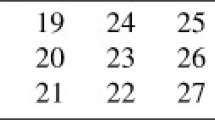Abstract
Recent studies find that women are less competitive than men. This gender difference in competitiveness has been suggested as one possible explanation for why men occupy the majority of top positions in many sectors. In this study we explore competitiveness in children, with the premise that both context and gendered stereotypes regarding the task at hand may influence competitive behavior. A related field experiment on Israeli children shows that only boys react to competition by running faster when competing in a race. We here test if there is a gender gap in running among 7–10 year old Swedish children. We also introduce two female sports, skipping rope and dancing, to see if competitiveness is task dependent. We find no gender difference in reaction to competition in any task; boys and girls compete equally. Studies in different environments with different types of tasks are thus important in order to make generalizable claims about gender differences in competitiveness.
Similar content being viewed by others
References
Apicella, C. L., Dreber, A., Gray, P. B., Hoffman, M., Little, A. C., & Campbell, B. C. (2011). Androgens and competitiveness in men. Journal of Neuroscience, Psychology and Economics, 4, 54–62.
Balafoutas, L., & Sutter, M. (2010). Gender, competition and the efficiency of policy intervention. Working Papers in Economics 450, Göteborg University, Department of Economics.
Booth, A., & Nolen, P. (2009). Choosing to compete: the role of single-sex education. Mimeo.
Buser, T. (2009). The impact of female sex hormones on competitiveness. Mimeo.
Cárdenas, J. C., Dreber, A., von Essen, E., & Ranehill, E. (2010). Gender differences in competitiveness and risk taking: comparing children in Colombia and Sweden. Journal of Economic Behavior and Organization (in press).
Ceci, S., & Williams, W. (2006). Why aren’t more women in science. Washington: American Psychological Association.
Chen, Y., Katuscak, P., & Ozdenoren, E. (2005). Why can’t a woman bid more like a man? Mimeo.
Cotton, C., McIntyre, F., & Price, J. (2009). Gender differences disappear with exposure to competition. Working Paper 2010-11, University of Miami, Department of Economics.
Datta Gupta, N., Poulsen, A., & Villeval, M.-C. (2005). Male and female competitive behavior—experimental evidence. IZA Discussion Paper, No. 1833.
Fernández, R., & Fogli, A. (2006). Fertility: the role of culture and family experience. Journal of the European Economic Association, 4, 552–561.
Gneezy, U., & Rustichini, A. (2004a). Gender and competition at young age. American Economic Review Papers and Proceedings, 118, 1049–1074.
Gneezy, U., & Rustichini, A. (2004b). Executives versus teachers. Mimeo.
Gneezy, U., Leonard, K. L., & List, J. A. (2009). Gender differences in competition: evidence from a matrilineal and a patriarchal society. Econometrica, 77, 909–931.
Gneezy, U., Niederle, M., & Rustichini, A. (2003). Performance in competitive environments: gender differences. The Quarterly Journal of Economics, 118, 1049–1074.
Grosse, N. D., & Reiner, G. (2010). Explaining gender differences in competiteveness: gender-task stereotypes. Jena Economic Research Paper.
Günther, C., Ekinici, N. A., Schwieren, C., & Strobel, M. (2009). Women can’t jump?—An experiment on competitive attitudes and stereotype threat. Working Paper, University of Graz.
Henschel-Pellet, H. A. (2001). Physical activity gender role stereotyping: an analysis of Children’s Literature. Research Quarterly, 72.
Inzlicht, M., & Ben-Zeev, T. (2003). Do high-achieving female students underperform in private? The implications of threatening environments on intellectual processing. Journal of Educational Psychology, 95, 796–805.
Niederle, M., & Vesterlund, L. (2007). Do women shy away from competition? Do men compete too much? The Quarterly Journal of Economics, 122, 1067–1101.
Niederle, M., Segal, C., & Vesterlund, L. (2009). How costly is diversity? Affirmative action in light of gender differences in competitiveness. Mimeo.
Niederle, M., & Yestrumskas, A. H. (2008). Gender differences in seeking challenges: the role of institutions. Mimeo.
O’Brien, L. T., & Crandall, C. S. (2003). Stereotype threat and arousal: effects on women’s math performance. Personality and Social Psychology Bulletin, 29, 782–789.
Pearson, M., & Schipper, B. C. (2009). Menstrual cycle and competitive bidding. MPRA Paper.
Price, J. (2008). Gender difference in the response to competition. Industrial and Labor Relations Review, 61, 320–333.
Shih, M., Pittinsky, T. L., & Ambady, N. (1999). Stereotype susceptibility: shifts in quantitative performance from sociocultural identification. Psychological Science, 10, 81–84.
Spencer, S., Steele, C., & Quinn, D. (1999). Stereotype threat and women’s math performance. Journal of Experimental and Social Psychology, 35, 4–28.
Steele, C. M. (1997). A threat in the air. How stereotypes shape intellectual identity and performance. The American Psychologist, 52, 613–629.
Sutter, M., & Rützler, D. (2010). Gender differences in competition emerge early in life. IZA Discussion Paper 5015.
Wozniak, D., Harbaugh, W., & Mayr, U. (2010). Choices about competition: differences by gender and hormonal fluctuations, and the role of relative performance feedback. MPRA Paper.
Zethraeus, N., Kocoska-Maras, L., Ellingsen, T., von Schoultz, B., Lindén Hirschberg, A., & Johannesson, M. (2009). A randomized trial of the effect of estrogen and testosterone on economic behavior. Proceedings of the National Academy of Sciences of the United States of America, 106, 6535–6538.
Author information
Authors and Affiliations
Corresponding author
Rights and permissions
About this article
Cite this article
Dreber, A., von Essen, E. & Ranehill, E. Outrunning the gender gap—boys and girls compete equally. Exp Econ 14, 567–582 (2011). https://doi.org/10.1007/s10683-011-9282-8
Received:
Accepted:
Published:
Issue Date:
DOI: https://doi.org/10.1007/s10683-011-9282-8




